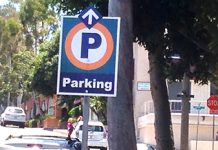The long-debated installation of a traffic signal at the main entrance to Laguna Beach’s largest gated community comes before the county planning commission at 1 p.m. Wednesday, Nov. 10.
Installation of a half-light at Emerald Bay’s main entrance would allow residents and visitors to exit southbound while halting northbound traffic on Coast Highway. In addition, the Emerald Bay Service District is seeking approval for a permit to reconstruct the entryway with additional lanes, requiring grading an internal slope in a private park.
The $3.5 million project is expected to reduce the possibility of collisions at rush hour and at night even though the intersection’s accident history does not meet the “warranted” threshold, Jason Osman, Caltrans’ chief traffic safety engineer, said in a March 10 letter to the service district.
Interestingly, the T intersection “could not be built in the same configuration today,” because it falls short of Caltrans’ visibility standards, says a report on the project’s mitigated negative declaration, circulated July 16-Aug. 17.
The project “has Caltrans’ unequivocal support,” said John McDermott, a former president of the service district, an elected body responsible for infrastructure behind the green gates and a proponent of the signal drive. Two Caltrans officials told him 85 percent of the traffic signals installed statewide don’t meet high-accident warrants.
More than 118 backers of the project have submitted written support to the county public works department, while 17 have sent letters of opposition, according to county spokeswoman Debbie Kroner.
Even so, the internal dispute spills over into the broader community since Coast Highway commuters will be hitting the breaks on their way out of town should the new signal win approval.
Three dissidents who oppose the plan this past Tuesday lost their bid for seats on the service district, which receives a 10 percent share of property tax revenue from the 540 homeowners to maintain services such as sewer and fire. Residents also pay annual dues of $6,000 to $9,000 to a separate association for maintenance of common areas.
Defeated service-district candidate Scott McCarter said and fellow candidates Pete Collison and Steve Rabago wanted a referendum on the project. Projects of a certain size are routinely put to a vote of residents, but service district officials say safety issues are not subject to popular vote, he said.
Opponents cite potential slope instability and construction and traffic noise. Others suggest less expensive and less intrusive solutions could solve the queing and turning problem.
“Bogus objections,” said McDermott, adding that the district has explored solutions, such as limiting a homeowner to five construction vehicles a day. Closing the main gate to left turns would force vehicles to the community’s other exits on roads not intended to accommodate significant traffic, he said.
The district has established reserves to pay $2.65 million of the project’s costs, McDermott said. The previous homeowner association president informed the district the project’s remaining $925,000 cost would be financed and repaid through cash flow, without the need of a special assessment.




